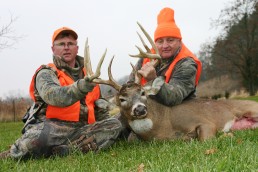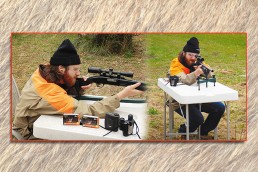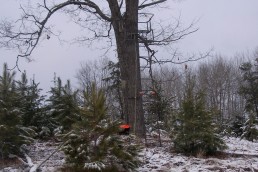Finding a Great Gun Stand
SHARE THIS POST
Finding a great gun stand usually takes time, effort and ingenuity. Yes, I’ll agree that once in a while a hunter stumbles onto a great spot by sheer luck. But more often, good gun stands are found by scouting, map reading and trial and error from previously unsuccessful hunts. Usually, this also involves a bit of legwork.
Many great gun stands actually take years to dial in through said trial and error. Quite often, you will be “close, but no cigar” when initially choosing a stand location. In other words, you’ll find what you think is a great setup only to glimpse a big buck and have no shot opportunity. Or, it appears at long range in a somewhat unexpected location, then quickly disappears. Whenever this happens repeatedly from a stand, it’s imperative to move the necessary distance in order to spot these sneaky gun-season bucks quicker and at closer ranges for more high-percentage shots.

Would-be firearm deer hunters, who also spend time in the same piece of woods earlier in the fall with a bow, are sure to reap the rewards of that extra time in terms of learning both deer movement and terrain knowledge. In any given chunk of woods, deer are certain to bed in areas of thick cover or steep terrain as well as travel along specific trails. Knowing precisely or even approximately where they travel, feed and bed is sure to help the firearm hunter. However, it is important to note that deer habitat and feeding preferences are apt to be different by late November when most gun seasons occur.
You can almost bank on the fact that deer will no longer be cruising through open hardwood flats once the leaves drop. The woods are simply too naked of both cover and food. In areas of relatively level topography with very little hilly terrain, 2- to 5-year-old clear-cuts are usually hot deer prospects; they offer both cover and food in one spot. Add an adjacent conifer swamp to this formula and you’ve got a possible winner. Spend some scouting time looking for hot deer sign once you locate a clear-cut with a nearby conifer swamp. Locate a stand downwind of this sign and you should be in business.
Hilly terrain or steep grades with thorny underbrush offer some of the best habitat for late-November whitetails in western Wisconsin, eastern Minnesota and western Illinois. Bluff-country whitetails are famous for hunkering tight to steep, brushy terrain during gun season. They can feed and bed in terrain like this without ever having to leave it. Typically, they bed on little flat spots often called “benches” and slip along thorny trails to browse inside thick cover. Much of this cover is so thick a clean shot is nearly impossible.
The key gun stand in bluff country is either above or below a probable deer location, yet offers some clean shooting lanes through brush. This isn’t always easy to find. Quite often, you can see the deer sneaking through, but you can’t get a shot past the thick stuff. It takes some stealthy maneuvering in order to find a perfect-shot window. With enough diligence, this can usually be accomplished. Sometimes, one needs to go into these spots the following spring and actually “hack out” a few shooting lanes. Don’t even think of attempting this a few days before gun season or you’ll spook everything out. Do it way ahead of time.
Large draws and ditches with a lot of deadfalls and blowdowns in them can also be super gun season hot spots. My good friend, Mike Novak, hunts this kind of cover all the time and has taken some dandy big bucks from this type of terrain. One of his favorite tricks is to hunt right inside a big ditch that is full of deadfalls, brush and swirling winds. The deer really gravitate to these wood-tangled ditches once the leaves drop and the gun-hunting pressure heats up. They are nearly impossible to bowhunt due to the swirling winds, but Mike claims it’s a different ballgame with a firearm.
Are you enjoying this post?
You can be among the first to get the latest info on where to go, what to use and how to use it!
Recently over a dinner I asked him what makes his gun stand so good.
“I’d say what makes my particular spot a great one is the long-range visibility of major deer sign everywhere within 150 yards, which is the range of my slug gun,” Mike said. “There’s a hub of trails in front of me that converge at the bottom of the draw into a “highway” with multiple scrapes in different directions, rubs everywhere and the possibility of many bucks making this sign.
“I’ve had a difficult time bowhunting here since the deer ‘wind’ me before they’re in range. However, during gun season, by the time they smell me it’s too late. These gun-season bucks are on a mission too—they are moving quickly along trails in search of does and not mingling around scrapes and other sign. Also, some deer are simply being pushed into these nasty draws by hunting pressure. I’ve seen bucks come in here from every direction.
“I place my treestand higher than usual for better visibility and it is set up on a bench at the south slope of the draw. It’s about 20 feet up to the platform and makes it seem even higher when hunting on the slope. I can see the entire bottom of the bowl and can shoot virtually anywhere they enter.”
Wow! This stand sounds awesome.
Mike spent a great deal of time and effort to locate this hot spot. Once he did, the taxidermy bills started. Trial and error, combined with some legwork and ingenuity, are often what it takes to find a great gun stand. Every piece of woods has one. You just have to find it.
MWO
SHARE THIS POST
Did you enjoy this post?
You can be among the first to get the latest info on where to go, what to use and how to use it!
Joe Bucher
Joe Bucher is a Freshwater Fishing Hall of Fame Legendary Angler, book author, lure designer and host of Fishing with Joe Bucher TV series.



